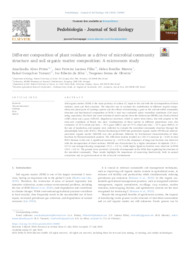Different composition of plant residues as a driver of microbial community structure and soil organic matter composition: a microcosm study.
Different composition of plant residues as a driver of microbial community structure and soil organic matter composition: a microcosm study.
Author(s): PRIMO, A. A.; LUSTOSA FILHO, J. F.; MAROTA, H. B.; TONUCCI, R. G.; SILVA, I. R. da; OLIVEIRA, T. S. de
Summary: Soil organic matter (SOM) is the main pathway of carbon (C) input to the soil with the decomposition of shoot residues, roots and their exudates. The objective was to evaluate the contribution of different vegetal composition and plant parts of Caatinga species and the effects of introducing a grass in the soil microbial community structure and biochemical composition of SOM. A trial was conducted under controlled conditions (120 days) using, separately, the shoot and roots residues of native species from the herbaceous (HERB) and shrub-arboreal (ARB) strata and a grass (GRASS). Megathyrsus maximum, which is native from Africa, but well adapted to the semi-arid conditions of Brazil, was used. Combinations of these species in different proportions were also evaluated: (i) 55 % shrub and trees + 45 % grass (MIX1) and (ii) 75 % shrub and trees + 25 % grass (MIX2). At the end of incubation, soil samples were collected to evaluate the microbial community structure through the phospholipid fatty acids (PLFA). Physical fractioning of SOM into particulate organic matter (POM) and mineralassociated organic matter (MAOM) was also performed, followed by biochemical characterization of these fractions by thermochemolysis analysis. The ARB shoot residue resulted in a 181.5 % increase (p < 0.05) in total PLFA biomass in the soil. A significant increase (p < 0.05) in the abundance of fungi and bacteria was observed with the incorporation of shoot residues. MAOM was characterized by a higher abundance of aliphatic (31.6 ± 5.0 %) and nitrogen-bearing compounds (21.0 ± 2.0 %), while higher lignin derivatives were observed in POM (18.0 ± 0.6 %). The ground cover provided a diversity of compounds in the SOM, thus regulating the structure of the microbial community. These results highlight the importance of conserving biodiversity, both in natural ecosystems and in agroecosystems in the semi-arid environment.
Publication year: 2024
Types of publication: Journal article
Unit: Embrapa Dairy Cattle
Keywords: Caatinga, Comunidade microbiana, MAOM, Matéria Orgânica, POM, Solo, Thermochemolysis
Observation
Some of Embrapa's publications are published as ePub files. To read them, use or download one of the following free software options to your computer or mobile device. Android: Google Play Books; IOS: iBooks; Windows and Linux: Calibre.
Access other publications
Access the Agricultural Research Database (BDPA) to consult Embrapa's full library collection and records.
Visit Embrapa Bookstore to purchase books and other publications sold by Embrapa.

